Psoriasis Drug Market
Psoriasis Drug Market Size and Share Forecast Outlook 2025 to 2035
Psoriasis drug market is projected to grow from USD 23.3 billion in 2025 to USD 66.3 billion by 2035, at a CAGR of 11.0%. Tumor Necrosis Factor Inhibitors (TNF) will dominate with a 40.9% market share, while parenteral will lead the treatment segment with a 41.6% share.
Psoriasis Drug Market Forecast and Outlook 2025 to 2035
The global psoriasis drug market is projected to grow from USD 23.3 billion in 2025 to approximately USD 66.3 billion by 2035, expanding at a compound annual growth rate (CAGR) of 11.0% between 2025 and 2035. The market is positioned for substantial expansion, driven by accelerating biologic therapy adoption, expanding interleUKin inhibitor approvals, and increasing diagnosis rates of moderate-to-severe psoriasis across dermatology centers, specialty hospitals, and primary care facilities globally.
Quick Stats on Psoriasis Drug Market
- Psoriasis Drug Market Value (2025): USD 23.3 billion
- Psoriasis Drug Market Forecast Value (2035): USD 66.3 billion
- Psoriasis Drug Market Forecast CAGR (2025 to 2035): 11.0%
- Leading Drug Class in Psoriasis Drug Market: TNF Inhibitors (40.9%)
- Leading Route of Administration in Psoriasis Drug Market: Parenteral (41.6%)
- Leading Distribution Channel in Psoriasis Drug Market: Hospital Pharmacies (48.0%)
- Key Growth Regions in Psoriasis Drug Market: North America, Europe, and Asia Pacific
- Key Players in Psoriasis Drug Market: AbbVie, Amgen, Johnson & Johnson, Novartis, Eli Lilly, AstraZeneca, Celgene, UCB, Merck, Boehringer Ingelheim
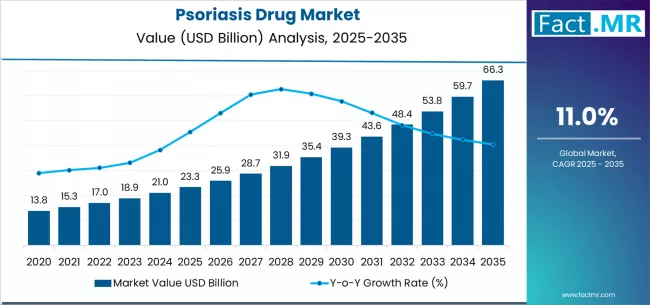
The market demonstrates robust fundamentals supported by growing deployment of targeted biologic therapies, dermatologists' focus on patient quality of life optimization and rising recognition of advanced psoriasis drug as critical therapeutic options in achieving enhanced disease control, symptom remission, and long-term management compliance within modern dermatological treatment architectures across diverse patient populations.
Market growth is underpinned by therapeutic innovations in psoriasis drug mechanisms, particularly interleUKin-17 (IL-17) inhibitors and interleUKin-23 (IL-23) antagonist platforms, which offer enhanced efficacy profiles, improved safety characteristics, and superior patient adherence compared to conventional systemic therapies prevalent in contemporary treatment paradigms.
Healthcare providers and dermatology specialists increasingly prioritize psoriasis treatments that deliver optimal balance between clinical efficacy, safety tolerability, and patient convenience while adhering to increasingly sophisticated treatment guidelines and personalized medicine requirements across global healthcare markets.
The convergence of biologic therapy market penetration in developed healthcare systems, biosimilar availability expansion in cost-sensitive markets, and targeted therapy development in precision dermatology corridors creates multifaceted growth opportunities for pharmaceutical manufacturers and specialty biologic developers.
Advanced psoriasis drug technologies incorporating monoclonal antibody platforms, subcutaneous self-administration devices, and extended dosing interval formulations are improving treatment adherence, patient satisfaction, and therapeutic outcomes across dermatological applications.
The market's trajectory reflects the dermatology sector's increasing shift toward biologic-first treatment strategies for moderate-to-severe psoriasis, the expanding role of interleUKin inhibitors in achieving complete skin clearance, and the growing integration of personalized medicine platforms requiring sophisticated biomarker-guided therapeutic selection.
Disease management optimization programs and patient support service networks are establishing comprehensive frameworks for long-term treatment adherence advancement, while specialty pharmacy infrastructure development enables enhanced medication access and seamless patient care coordination across global dermatology and healthcare operations.
Between 2020 and 2025, the psoriasis drug market expanded from USD 12.8 billion to USD 23.3 billion, demonstrating exceptional foundational growth driven by blockbuster biologic launches, increasing moderate-to-severe psoriasis treatment rates, and accelerated deployment of interleUKin inhibitor therapies across specialty dermatology and hospital-based treatment platforms. This growth phase established specialty pharmacy infrastructure, validated biologic treatment paradigms, and created comprehensive patient support systems supporting global dermatological care operations.
From 2025 to 2030, the market is projected to accelerate substantially, reaching USD 39.2 billion, representing a critical inflection point as biologic therapies transition from specialty dermatology applications to broader primary care adoption and as biosimilar competition reshapes treatment economics across major healthcare markets. This period will be characterized by next-generation IL-23 inhibitor launches, enhanced patient access programs, and widespread deployment of extended-interval biologic formulations across all disease severity segments.
From 2030 to 2035, the market is forecast to reach USD 66.3 billion, driven by mature biologic market penetration in developed regions, emerging market biosimilar adoption acceleration, and comprehensive integration of personalized medicine platforms enabling biomarker-guided therapeutic selection. The growing adoption of oral small molecule inhibitors, topical biologic formulations, and digital health monitoring systems will drive demand for comprehensive psoriasis management solutions with enhanced patient convenience and seamless healthcare provider integration functionality.
Psoriasis Drug Market Key Takeaways
| Metric | Value |
|---|---|
| Estimated Value (2025E) | USD 23.3 billion |
| Forecast Value (2035F) | USD 66.3 billion |
| Forecast CAGR (2025 to 2035) | 11.0% |
Why is the Psoriasis Drug Market Growing?
Market expansion is being supported by the substantial increase in psoriasis diagnosis rates and the corresponding need for effective disease management therapies in dermatological applications across global healthcare systems. Modern dermatology providers are increasingly focused on biologic therapies that can achieve complete skin clearance, improve patient quality of life, and maintain long-term disease control while meeting evolving treatment guidelines.
The proven clinical efficacy of biologic drug in moderate-to-severe psoriasis makes them essential components of comprehensive disease management strategies and specialty care integration programs. The growing emphasis on patient-centered care and treatment outcome optimization is driving demand for advanced psoriasis drug that meet stringent efficacy requirements and safety specifications for dermatological applications.
Healthcare providers' preference for therapies with rapid onset of action, sustained disease control, and favorable safety profiles is creating opportunities for innovative biologic mechanisms and next-generation therapeutic solutions. The rising influence of treatment guidelines and quality-of-life outcome measures is also contributing to increased adoption of targeted biologic therapies across different patient populations and disease severity categories requiring advanced immunomodulatory treatment.
Opportunity Pathways - Psoriasis Drug Market
The psoriasis drug market represents a transformative growth opportunity, expanding from USD 23.3 billion in 2025 to USD 66.3 billion by 2035 at an 11.0% CAGR. As healthcare systems prioritize treatment efficacy optimization, patient quality of life enhancement, and long-term disease management in chronic dermatological conditions, psoriasis therapies have evolved from symptomatic corticosteroid treatments to sophisticated biologic interventions enabling targeted immune pathway modulation, sustained disease remission, and personalized treatment approaches across moderate-to-severe patient populations and emerging mild disease applications.
The convergence of biologic therapy innovation acceleration, increasing specialty pharmacy infrastructure penetration, biosimilar market entry enabling access expansion, and evolving treatment paradigms creates substantial demand momentum. High-efficacy IL-23 inhibitors offering superior skin clearance outcomes, established TNF inhibitor platforms balancing efficacy with treatment experience, and emerging oral small molecules providing convenient administration will capture market value, while geographic expansion into high-growth Asian markets and emerging healthcare systems will drive volume and access leadership. Healthcare provider emphasis on complete skin clearance and sustained remission provides structural support.
- Pathway A - TNF Inhibitor Class Dominance: Leading with 40.9% market share, TNF inhibitor applications drive primary demand through established clinical experience and proven efficacy in moderate-to-severe psoriasis requiring comprehensive immunomodulatory therapy. Established TNF inhibitor platforms including adalimumab, etanercept, and infliximab formulations maintaining substantial prescription volumes from dermatologists and rheumatologists managing psoriatic disease while facing biosimilar competition pressure. Expected revenue pool: USD 9.5-27.1 billion.
- Pathway B - Parenteral Route Administration Leadership: Dominating with 41.6% market share through optimal delivery of biologic therapies and proven treatment efficacy, parenteral administration serves most biologic drug requirements while meeting specialty care delivery standards. This route addresses both subcutaneous self-administration preferences and intravenous infusion protocols, making it the essential delivery method for biologic manufacturers and specialty healthcare providers. Opportunity: USD 9.7-27.6 billion.
- Pathway C - Emerging Market Acceleration: India (12.1% CAGR) and China (11.6% CAGR) lead global growth through healthcare infrastructure modernization, rising diagnosis rates, and expanding access to biologic therapies. Strategic market entry through biosimilar partnerships, local manufacturing presence, and patient assistance programs enable psoriasis drug expansion in high-population healthcare markets. Geographic expansion upside: USD 7.8-22.4 billion.
- Pathway D - Hospital Pharmacy Distribution Channel: Hospital pharmacies with 48.0% market share serve specialty drug distribution requiring comprehensive patient management for biologic therapy administration. Optimized specialty pharmacy infrastructure supporting patient education, reimbursement navigation, and medication adherence programs maintains significant volumes from academic medical centers and specialty dermatology practices. Revenue potential: USD 11.2-31.8 billion.
- Pathway E - Next-Generation Biologic Innovation & IL Inhibitors: Companies investing in sophisticated IL-23 selective inhibitors, dual IL-17/IL-23 antagonists, and novel immune pathway targets gain competitive advantages through superior efficacy profiles and differentiated safety characteristics. Advanced biologic platforms enabling extended dosing intervals and oral formulation development capture premium pricing and market share. Innovation premium: USD 6.3-17.9 billion.
- Pathway F - Specialty Pharmacy Networks & Patient Support: Specialized distribution infrastructure, comprehensive patient assistance programs, and integrated adherence support systems create competitive differentiation in biologic markets requiring complex care coordination. Companies offering financial assistance, nursing support services, and digital health monitoring gain treatment persistence advantages with payers and providers. Patient support value: USD 4.9-14.0 billion.
- Pathway G - Biosimilar Market Entry & Access Expansion: Beyond originator biologic franchises, biosimilar adalimumab, etanercept, and emerging IL inhibitor biosimilars represent substantial market access opportunities. Companies developing biosimilar portfolios, establishing specialty distribution channels, and capturing market share through competitive pricing strategies enable treatment access expansion while disrupting established brand revenues. Biosimilar opportunity: USD 3.7-10.6 billion.
Segmental Analysis
The market is segmented by class, treatment, route of administration, distribution channel, and region. By class, the market is divided into tumor necrosis factor inhibitors, interleUKin inhibitors, vitamin D analogues, corticosteroids, and others.
Based on treatment, the market is categorized into oral, parenteral, and topical. By route of administration, the market is segmented into parenteral, oral, and topical. By distribution channel, the market is divided into hospital pharmacies, retail pharmacies, and others. Regionally, the market is divided into North America, Europe, Asia Pacific, Latin America, and mea.
How do TNF Inhibitors Drive Drug Class Leadership?
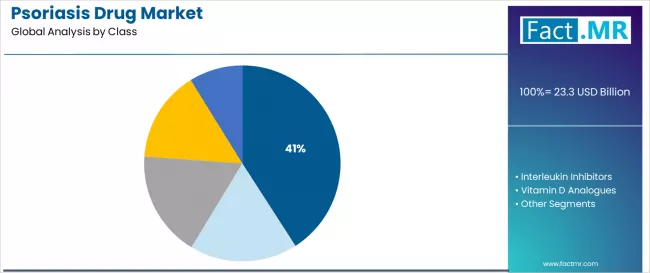
The tumor necrosis factor (TNF) inhibitor class is projected to account for 40.9% of the psoriasis drug market in 2025, reaffirming its position as the category's dominant therapeutic mechanism. Dermatologists and healthcare providers increasingly recognize the established clinical evidence and proven long-term efficacy offered by TNF inhibitor therapies for moderate-to-severe psoriasis, particularly in patients requiring systemic immunomodulation and comprehensive disease management environments. This drug class addresses both plaque psoriasis treatment requirements and psoriatic arthritis comorbidity management while providing extensive real-world safety experience across diverse patient populations.
This segment forms the foundation of most biologic treatment protocols for moderate-to-severe psoriasis and psoriatic arthritis management, as it represents the first-generation and most clinically established biologic mechanism in the psoriasis therapeutics landscape. Clinical guideline positioning and extensive post-marketing surveillance data continue to strengthen provider confidence in TNF inhibitor therapies among dermatologists and rheumatology specialists. Despite emerging competition from newer interleUKin inhibitors, TNF inhibitor platforms maintain substantial market presence through biosimilar availability, established prescriber familiarity, and proven efficacy-safety profiles, making them central components of comprehensive psoriasis treatment strategies across multiple care settings.
Why does Parenteral Route Command Majority Administration Share?
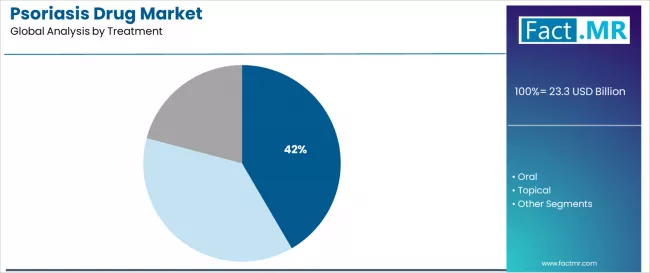
Parenteral route of administration is projected to represent 41.6% of psoriasis drug delivery in 2025, underscoring its role as the primary administration method driving biologic therapy utilization. Healthcare providers and patients recognize that parenteral delivery requirements, encompassing subcutaneous injection and intravenous infusion modalities, represent the necessary administration approach for biologic immunomodulatory therapies that oral and topical routes cannot accommodate due to molecular size and bioavailability limitations.
Parenteral administration methods enable effective systemic delivery essential for achieving therapeutic biologic drug concentrations and comprehensive immune pathway modulation. The segment is supported by the expanding nature of biologic therapy adoption in moderate-to-severe psoriasis management, requiring administration routes capable of delivering large-molecule therapeutics, maintaining drug stability, and achieving predictable pharmacokinetics, alongside increasing recognition that subcutaneous self-administration can improve patient convenience and treatment adherence.
Pharmaceutical companies are increasingly developing patient-friendly injection devices and autoinjector technologies that facilitate home administration for optimal treatment accessibility and healthcare system efficiency. As biologic therapy utilization expands and patient self-administration capabilities advance, parenteral routes will continue serving their essential role in comprehensive psoriasis biologic therapy strategies.
What drives Hospital Pharmacy Distribution Channel Prominence?
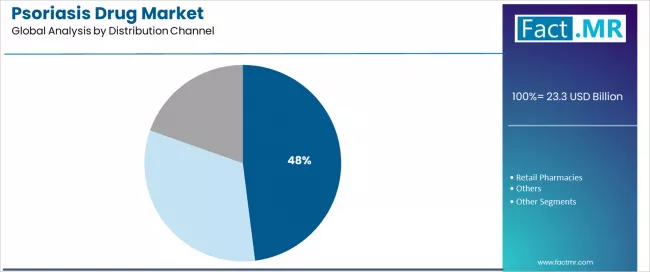
The hospital pharmacy distribution channel is projected to account for 48.0% of the psoriasis drug market in 2025, establishing its position as the leading distribution pathway segment. Healthcare systems increasingly recognize that hospital pharmacy operations, encompassing specialty pharmacy services and infusion center coordination, represent the most comprehensive distribution infrastructure for biologic therapies due to complex handling requirements, patient education needs, and reimbursement navigation support.
This channel addresses both specialty drug distribution logistics and patient care coordination requirements while delivering reliable medication access across diverse payer environments. The segment is supported by the continuing nature of specialty biologic prescribing through hospital-affiliated practices and academic dermatology centers, driven by prior authorization complexity, specialty pharmacy network requirements, and integrated patient support service delivery.
Healthcare systems are increasingly establishing dedicated specialty pharmacy operations that provide comprehensive medication therapy management, financial assistance coordination, and adherence monitoring to optimize treatment outcomes and medication persistence. As biologic therapy complexity continues and specialty drug management requirements expand, hospital pharmacy channels will maintain their crucial role in ensuring medication access and patient support within the global psoriasis treatment ecosystem.
What are the Drivers, Restraints, and Key Trends of the Psoriasis Drug Market?
The psoriasis drug market is advancing rapidly due to increasing recognition of psoriasis disease burden and growing demand for effective biologic therapies across the dermatology specialty sector.
However, the market faces challenges, including high treatment costs creating access barriers in uninsured populations, potential for insurance coverage restrictions and prior authorization requirements limiting therapy initiation, and concerns about long-term immunosuppression safety in certain patient subgroups. Innovation in drug delivery technologies and emerging oral small molecule platforms continues to influence treatment paradigm evolution and market expansion patterns.
Proliferation of InterleUKin Inhibitor Therapies and Precision Targeting
The accelerating development of interleUKin-selective inhibitor platforms is enabling more sophisticated psoriasis treatment applications and therapeutic mechanisms that can achieve superior clinical outcomes and safety profiles.
Dermatology providers demand highly selective immunomodulation for psoriasis management, including IL-23 p19 subunit-specific targeting and IL-17A pathway inhibition formulations that are particularly important for achieving complete skin clearance requirements in moderate-to-severe presentations. Next-generation interleUKin inhibitors provide enhanced efficacy profiles compared to TNF inhibitors while potentially offering improved long-term safety characteristics through more selective immune pathway targeting.
Integration of Biosimilar Competition and Access Expansion Programs
Modern healthcare systems are incorporating biosimilar therapy options such as adalimumab biosimilars, etanercept biosimilars, and emerging IL inhibitor biosimilar candidates to enhance psoriasis drug accessibility and healthcare cost management.
These alternatives improve treatment affordability dynamics, enable broader patient access to biologic therapies, and provide competitive pressure supporting price moderation across the therapeutic landscape. Biosimilar availability also enables innovative patient assistance programs and expanded insurance coverage facilitating treatment initiation for cost-sensitive patient populations previously unable to access originator biologic therapies.
Analysis of the Psoriasis Drug Market by Key Countries
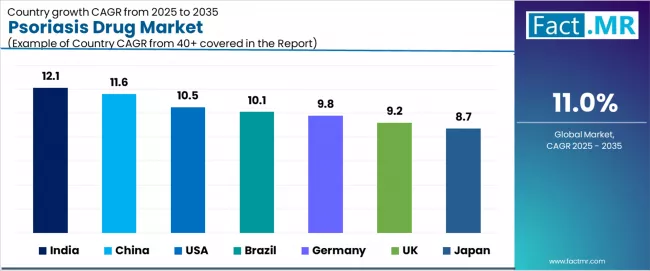
| Country | CAGR (2025-2035) |
|---|---|
| India | 12.1% |
| China | 11.6% |
| usa | 10.5% |
| Brazil | 10.1% |
| Germany | 9.8% |
| UK | 9.2% |
| Japan | 8.7% |
The psoriasis drug market is experiencing exceptional growth globally, with India leading at a 12.1% CAGR through 2035, driven by rising diagnosis rates, expanding healthcare infrastructure access, and increasing availability of biosimilar biologic therapies across urban medical centers. China follows at 11.6%, supported by healthcare modernization initiatives, growing middle-class insurance coverage, and comprehensive pharmaceutical market development. The USA records 10.5% growth, benefiting from continued biologic adoption and FDA approvals of next-generation therapies.
Brazil demonstrates 10.1% growth, emphasizing expanding access to biologics and specialty pharmacy infrastructure development. Germany shows 9.8% growth, representing strong reimbursement systems and biosimilar market penetration. UK records 9.2% growth with NHS biologic uptake and treatment guideline evolution, while Japan shows 8.7% growth, representing aging population demographics and established biologic therapy infrastructure.
How Does India Demonstrate Exceptional Market Potential with Rising Diagnosis and Generic Access?
The psoriasis drug market in India is projected to exhibit exceptional growth with a CAGR of 12.1% through 2035, driven by rapidly rising diagnosis rates and increasing recognition of psoriasis as a treatable chronic condition requiring long-term pharmaceutical management and dermatology specialty care. The country's expanding healthcare infrastructure and growing availability of biosimilar biologic therapies are creating significant opportunities for psoriasis drug deployment across both urban specialty hospitals and developing regional dermatology practices.
International pharmaceutical companies and domestic biosimilar manufacturers are establishing market presence to serve the expanding population of diagnosed patients and healthcare providers requiring psoriasis therapies across TNF inhibitor, interleUKin inhibitor, and conventional systemic treatment applications throughout India's major metropolitan and tier-2 city healthcare systems.
The Indian government's healthcare coverage expansion programs and growing private insurance penetration are driving improved access to specialty medications and dermatology care services. This policy evolution, combined with the country's world-leading biosimilar manufacturing capabilities and cost-competitive healthcare delivery, creates a favorable environment for psoriasis drug market development. Indian healthcare providers are increasingly focusing on biologic therapy adoption to address unmet treatment needs, with biosimilar products representing key enablers in expanding patient access beyond conventional systemic therapies.
- Government healthcare initiatives and insurance expansion programs driving improved access to specialty dermatology care and biologic therapies
- Growing disease awareness and dermatology infrastructure development supporting increased psoriasis diagnosis rates among patient populations nationwide
- Pharmaceutical companies and healthcare providers increasingly integrating biologic treatment protocols into psoriasis management, creating new therapeutic access opportunities
- Rising biosimilar availability and growing middle-class healthcare spending accelerating biologic therapy adoption across patient segments
What makes China Demonstrate Market Leadership with Healthcare Modernization?
The psoriasis drug market in China is expanding at a CAGR of 11.6%, supported by healthcare modernization initiatives, growing middle-class insurance coverage, and advancing pharmaceutical market development across the country's rapidly evolving healthcare corridors.
The country's massive patient population and increasing healthcare system sophistication are driving demand for advanced psoriasis therapies in both tier-1 hospital dermatology departments and expanding specialty care networks. International pharmaceutical companies and domestic manufacturers are establishing comprehensive commercial infrastructure to serve growing demand for biologic therapies while supporting the country's position as a major emerging pharmaceutical market.
China's healthcare sector continues to benefit from National Reimbursement Drug List (NRDL) expansions, developing specialty pharmacy infrastructure, and government emphasis on innovative therapy access supporting treatment affordability. The country's focus on healthcare quality improvement is driving pharmaceutical market growth including advanced psoriasis biologics and specialty medications.
This development is particularly important for psoriasis drug access, as healthcare reforms seek to provide Chinese patients with treatment options comparable to developed markets while managing healthcare expenditure through negotiated pricing and domestic manufacturing.
- Healthcare modernization programs and insurance coverage expansion creating opportunities for advanced psoriasis therapy adoption
- Growing patient diagnosis rates and specialty dermatology infrastructure supporting increased deployment of biologic therapies across disease severity categories
- Pharmaceutical market development and NRDL inclusion processes driving innovative therapy access and treatment paradigm evolution
- Healthcare system advancement enabling biologic therapy adoption, supporting market growth and improving patient access to modern treatments
Why does USA Maintain Biologic Therapy Adoption Leadership?
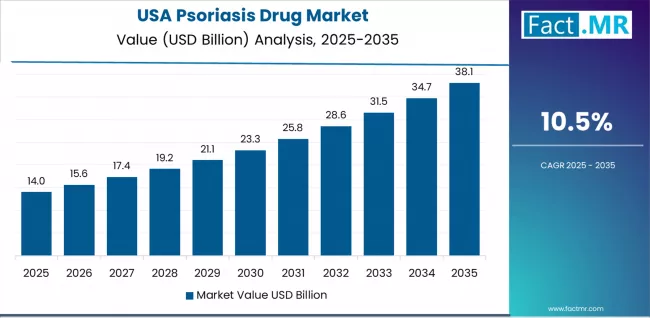
The psoriasis drug market in USA is projected to exhibit strong growth with a CAGR of 10.5% through 2035, driven by continued biologic therapy adoption and FDA regulatory approvals of next-generation interleUKin inhibitors.
The country's advanced healthcare infrastructure and comprehensive specialty pharmacy networks are creating sustained opportunities for innovative psoriasis drug utilization across both academic dermatology centers and community-based specialty practices. American pharmaceutical companies leverage extensive clinical development capabilities to serve growing demand for superior-efficacy biologics while maintaining the country's position as the global innovation leader in dermatological therapeutics.
The USA market benefits from comprehensive insurance coverage for specialty biologics despite high list prices, enabling optimized treatment access through specialty pharmacy channels and patient assistance programs. This healthcare infrastructure supports sustained biologic utilization as providers prioritize complete skin clearance outcomes and patient quality of life optimization over traditional treatment cost considerations.
Strategic Market Considerations:
- Moderate-to-severe psoriasis populations and specialty dermatology practices leading growth with focus on next-generation IL-23 inhibitors and extended-interval biologic applications
- Clinical outcome expectations driving premium therapy utilization from established TNF inhibitors to superior-efficacy IL inhibitor platforms
- Pharmaceutical innovation excellence and FDA regulatory pathways supporting competitive positioning in global dermatology therapeutics markets
- Biosimilar market entry and healthcare cost pressures beginning to influence treatment selection discussions and payer coverage determination timelines
How Does Brazil Maintain Expanding Biologic Access Growth?
Brazil's emerging pharmaceutical market demonstrates accelerating psoriasis drug adoption with documented growth in biologic therapy utilization and specialty care access through public healthcare system expansion and private insurance development. The country maintains healthcare infrastructure investment supporting a 10.1% CAGR through 2035. Urban dermatology centers, including major teaching hospitals and specialty practices, showcase expanding biologic implementations where TNF inhibitors and interleUKin inhibitor therapies provide treatment options for moderate-to-severe patient populations previously limited to conventional systemic therapies.
Brazilian healthcare providers increasingly recognize biologic therapy value despite economic constraints, creating demand for psoriasis treatments with established efficacy supporting public tender procurement and private insurance coverage. The market benefits from expanding healthcare access initiatives and growing recognition of psoriasis disease burden driving treatment prioritization within resource allocation decisions.
Strategic Market Considerations:
- Public healthcare system and private insurance segments demonstrating growth with focus on biosimilar access expansion and specialty care development
- Healthcare access initiatives driving therapy portfolios from conventional systemics to biologic treatment platforms
- Market development challenges offset by strong pharmaceutical industry presence and healthcare infrastructure investment
- Government procurement programs and biosimilar adoption beginning to accelerate therapy access timelines and treatment availability
What Drives Germany Market Growth with Strong Reimbursement Systems?
Germany's advanced healthcare market demonstrates sophisticated psoriasis drug utilization with a 9.8% CAGR through 2035, driven by strong reimbursement systems, comprehensive treatment guideline adherence, and accelerating biosimilar market penetration across dermatology practices.
The country's well-established specialty care infrastructure and favorable regulatory environment are creating sustained demand for both originator biologics and biosimilar alternatives across diverse patient populations and disease severity categories. German dermatologists maintain high biologic prescribing rates supported by comprehensive insurance coverage and established treatment pathways.
Market dynamics reflect robust therapy access that balances innovation adoption with biosimilar competition important to German healthcare system sustainability and cost-effectiveness priorities. Comprehensive dermatology infrastructure and established treatment guidelines create stable demand supporting both originator and biosimilar therapy utilization.
Strategic Market Considerations:
- Moderate-to-severe psoriasis management and biosimilar adoption leading growth with focus on cost-effective biologic access and treatment optimization
- Healthcare system priorities driving balanced therapy portfolios incorporating originator innovation and biosimilar alternatives
- Clinical excellence supported by extensive dermatology expertise and comprehensive treatment guideline infrastructure
- Biosimilar competition and healthcare cost management influencing prescribing patterns while maintaining treatment quality standards
How does the UK Demonstrate NHS Biologic Uptake?
The UK's established healthcare system demonstrates steady psoriasis drug growth with a 9.2% CAGR through 2035 driven by NHS biologic uptake expansion and evolving treatment guidelines. The country's NICE technology appraisals and NHS England commissioning decisions shape demand for psoriasis biologics with cost-effectiveness assessments and clinical outcome requirements. Healthcare providers work within NHS formulary frameworks emphasizing evidence-based medicine and value-based treatment selection.
Healthcare delivery focuses on specialty dermatology services providing biologic therapies alongside traditional systemics, creating diverse treatment utilization across patient populations. The market benefits from established clinical excellence and commitment to equitable healthcare access supporting therapy availability within resource constraints.
Strategic Market Considerations:
- NHS dermatology services and specialty centers demonstrating focused growth with emphasis on cost-effective biologic utilization and biosimilar adoption
- NICE appraisal processes driving therapy access timelines with evidence-based assessment and budget impact considerations
- Clinical guideline adherence supported by dermatology expertise and NHS treatment pathway infrastructure
- Healthcare cost pressures emphasizing biosimilar uptake and value-based treatment selection in psoriasis management applications
Why does Japan Show Aging Population Demographics Driving Steady Growth?
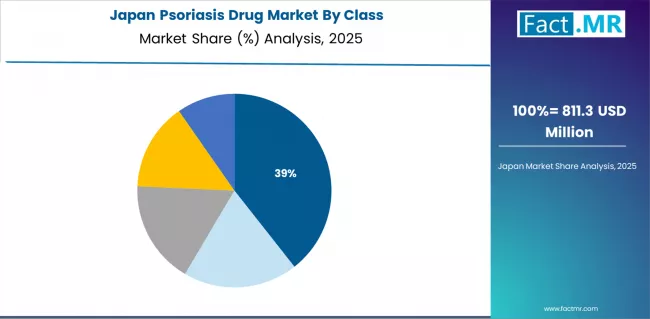
The psoriasis drug market in Japan is projected to grow at a CAGR of 8.7% through 2035, driven by aging population demographics and established biologic therapy infrastructure in mature healthcare environments. The country's universal healthcare coverage and comprehensive pharmaceutical reimbursement system maintain psoriasis drug utilization across dermatology specialty practices and hospital-based care. Japanese healthcare providers follow established treatment protocols emphasizing both efficacy and long-term safety supported by domestic clinical evidence and regulatory requirements.
The Japanese market benefits from complete pharmaceutical insurance coverage despite drug price reduction policies, supporting sustained specialty drug access and established prescribing patterns. This healthcare framework maintains foundation demand for psoriasis biologics as demographic trends support chronic disease medication utilization.
Strategic Market Considerations:
- Established patient populations and dermatology specialty care maintaining stable growth with focus on proven biologic platforms and safety profiles
- Healthcare system characteristics supporting continued therapy utilization balancing innovation access with cost containment policies
- Pharmaceutical market infrastructure supporting steady adoption as treatment paradigms evolve within regulatory frameworks
- Aging demographics and chronic disease prevalence supporting medication utilization despite healthcare system cost pressures
Europe Market Split by Country
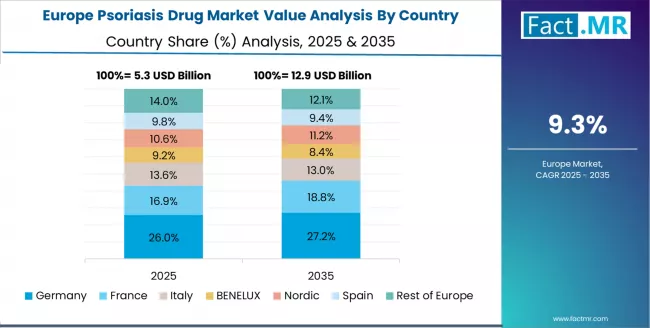
The psoriasis drug market in Europe is projected to grow from USD 6.8 billion in 2025 to USD 15.2 billion by 2035, registering a CAGR of 8.4% over the forecast period. Germany is expected to maintain its leadership position with a 26.4% market share in 2025, rising to 27.8% by 2035, supported by its comprehensive healthcare reimbursement system, extensive dermatology specialty infrastructure, and advanced biosimilar market development throughout established care delivery operations.
UK follows with a 21.2% share in 2025, projected to reach 22.1% by 2035, driven by NHS biologic commissioning programs, NICE technology appraisal frameworks, and evolving treatment guidelines serving national patient populations. France holds a 18.8% share in 2025, expected to increase to 19.4% by 2035, supported by specialty dermatology centers and comprehensive pharmaceutical reimbursement capabilities. Italy commands a 14.6% share in 2025, projected to reach 13.9% by 2035, while Spain accounts for 11.2% in 2025, expected to reach 10.4% by 2035.
The rest of Europe region, including Nordic countries with advanced healthcare systems, Eastern European emerging pharmaceutical markets, and smaller Western European healthcare systems, is anticipated to hold 7.8% in 2025, declining slightly to 6.4% by 2035, attributed to market consolidation toward larger core markets with established specialty care infrastructure and comprehensive biologic therapy access capabilities.
Competitive Landscape of the Psoriasis Drug Market
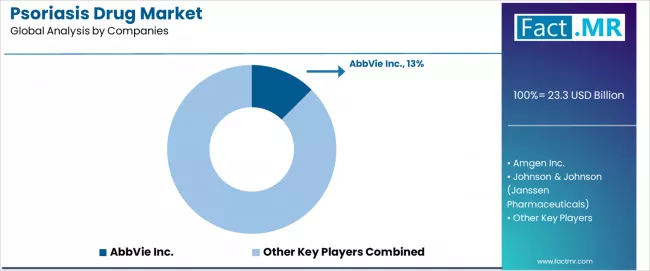
The psoriasis drug market is characterized by intense competition among established biopharmaceutical companies, specialty pharmaceutical manufacturers, and emerging biotech organizations focused on delivering high-efficacy, well-tolerated, and clinically differentiated immunomodulatory therapies.
Companies are investing in next-generation biologic innovation, clinical development program expansion, strategic payer partnership development, and comprehensive patient support service integration to deliver effective, convenient, and accessible therapeutic solutions that meet stringent dermatology treatment standards and payer value requirements. Lifecycle management strategies, biosimilar defense programs, and specialty pharmacy channel partnerships are central to strengthening market position and revenue sustainability.
AbbVie leads the market with a 12.5% market share, offering comprehensive psoriasis therapy portfolio with focus on market-leading TNF inhibitor (Humira/adalimumab) and IL-23 inhibitor (Skyrizi/risankizumab) platforms for moderate-to-severe disease applications. Amgen provides established biologic therapies with emphasis on IL-17 inhibitor (Otezla/apremilast oral) and TNF inhibitor technologies across global dermatology markets.
Johnson & Johnson focuses on leading IL-12/23 inhibitor (Stelara/ustekinumab) and maintains strong market presence serving international patient populations. Novartis delivers innovative IL-17A inhibitor (Cosentyx/secUKinumab) with comprehensive clinical evidence and established market penetration.
Eli Lilly operates with focus on differentiated IL-23 and IL-17 inhibitor platforms expanding market presence through superior efficacy positioning. AstraZeneca provides emerging IL-23 inhibitor contributing to portfolio diversification. Celgene (Bristol Myers Squibb) specializes in oral small molecule (Otezla/apremilast) offering convenient alternative to injectable biologics.
UCB delivers established IL-12/23 inhibitor maintaining European market presence. Merck and Boehringer Ingelheim focus on emerging pipeline candidates and established dermatology franchises for psoriasis and related inflammatory conditions, emphasizing clinical differentiation and market access strategies through comprehensive commercial execution.
Key Players in the Psoriasis Drug Market
- AbbVie Inc.
- Amgen Inc.
- Johnson & Johnson (Janssen Pharmaceuticals)
- Novartis AG
- Eli Lilly and Company
- AstraZeneca plc
- Celgene Corporation (Bristol Myers Squibb)
- UCB S.A.
- Merck & Co., Inc.
- Boehringer Ingelheim GmbH
Scope of the Report
| Items | Values |
|---|---|
| Quantitative Units (2025) | USD 23.3 Billion |
| Class | Tumor Necrosis Factor Inhibitors, InterleUKin Inhibitors, Vitamin D Analogues, Corticosteroids, Others |
| Treatment | Oral, Parenteral, Topical |
| Route of Administration | Parenteral, Oral, Topical |
| Distribution Channel | Hospital Pharmacies, Retail Pharmacies, Others |
| Regions Covered | North America, Europe, Asia Pacific, Latin America, mea |
| Countries Covered | usa, Germany, UK, Japan, India, China, Brazil and 40+ countries |
| Key Companies Profiled | AbbVie, Amgen, Johnson & Johnson, Novartis, Eli Lilly, AstraZeneca, Celgene, UCB, Merck, Boehringer Ingelheim |
| Additional Attributes | Dollar sales by class, treatment, route of administration, distribution channel, regional demand trends, competitive landscape, dermatologist preferences for specific therapeutic mechanisms, integration with specialty pharmacy systems, innovations in biologic delivery technologies, biosimilar market dynamics, and patient support program optimization capabilities |
Psoriasis Drug Market by Segments
-
Class :
- Tumor Necrosis Factor Inhibitors
- InterleUKin Inhibitors
- Vitamin D Analogues
- Corticosteroids
- Others
-
Treatment :
- Oral
- Parenteral
- Topical
-
Distribution Channel :
- Hospital Pharmacies
- Retail Pharmacies
- Others
-
Region :
- North America
- USA
- Canada
- Mexico
- Europe
- Germany
- France
- UK
- Italy
- Spain
- Nordic
- BENELUX
- Rest of Europe
- Asia Pacific
- China
- India
- Japan
- South Korea
- ASEAN
- Australia & New Zealand
- Rest of Asia Pacific
- Latin America
- Brazil
- Argentina
- Chile
- Rest of Latin America
- MEA
- Kingdom of Saudi Arabia
- Other GCC Countries
- Turkey
- South Africa
- Other African Countries
- Rest of MEA
- North America
Table of Content
- Executive Summary
- Global Market Outlook
- Demand to side Trends
- Supply to side Trends
- Technology Roadmap Analysis
- Analysis and Recommendations
- Market Overview
- Market Coverage / Taxonomy
- Market Definition / Scope / Limitations
- Market Background
- Market Dynamics
- Drivers
- Restraints
- Opportunity
- Trends
- Scenario Forecast
- Demand in Optimistic Scenario
- Demand in Likely Scenario
- Demand in Conservative Scenario
- Opportunity Map Analysis
- Product Life Cycle Analysis
- Supply Chain Analysis
- Investment Feasibility Matrix
- Value Chain Analysis
- PESTLE and Porter’s Analysis
- Regulatory Landscape
- Regional Parent Market Outlook
- Production and Consumption Statistics
- Import and Export Statistics
- Market Dynamics
- Global Market Analysis 2020 to 2024 and Forecast, 2025 to 2035
- Historical Market Size Value (USD Million) Analysis, 2020 to 2024
- Current and Future Market Size Value (USD Million) Projections, 2025 to 2035
- Y to o to Y Growth Trend Analysis
- Absolute $ Opportunity Analysis
- Global Market Pricing Analysis 2020 to 2024 and Forecast 2025 to 2035
- Global Market Analysis 2020 to 2024 and Forecast 2025 to 2035, By Class
- Introduction / Key Findings
- Historical Market Size Value (USD Million) Analysis By Class, 2020 to 2024
- Current and Future Market Size Value (USD Million) Analysis and Forecast By Class, 2025 to 2035
- Tumor Necrosis Factor Inhibitors (TNF)
- InterleUKin Inhibitors
- Vitamin D Analogues
- Corticosteroids
- Others
- Y to o to Y Growth Trend Analysis By Class, 2020 to 2024
- Absolute $ Opportunity Analysis By Class, 2025 to 2035
- Global Market Analysis 2020 to 2024 and Forecast 2025 to 2035, By Treatment
- Introduction / Key Findings
- Historical Market Size Value (USD Million) Analysis By Treatment, 2020 to 2024
- Current and Future Market Size Value (USD Million) Analysis and Forecast By Treatment, 2025 to 2035
- Parenteral
- Oral
- Topical
- Y to o to Y Growth Trend Analysis By Treatment, 2020 to 2024
- Absolute $ Opportunity Analysis By Treatment, 2025 to 2035
- Global Market Analysis 2020 to 2024 and Forecast 2025 to 2035, By Distribution Channel
- Introduction / Key Findings
- Historical Market Size Value (USD Million) Analysis By Distribution Channel, 2020 to 2024
- Current and Future Market Size Value (USD Million) Analysis and Forecast By Distribution Channel, 2025 to 2035
- Hospital Pharmacies
- Retail Pharmacies
- Others
- Y to o to Y Growth Trend Analysis By Distribution Channel, 2020 to 2024
- Absolute $ Opportunity Analysis By Distribution Channel, 2025 to 2035
- Global Market Analysis 2020 to 2024 and Forecast 2025 to 2035, By Region
- Introduction
- Historical Market Size Value (USD Million) Analysis By Region, 2020 to 2024
- Current Market Size Value (USD Million) Analysis and Forecast By Region, 2025 to 2035
- North America
- Latin America
- Western Europe
- Eastern Europe
- East Asia
- South Asia and Pacific
- Middle East & Africa
- Market Attractiveness Analysis By Region
- North America Market Analysis 2020 to 2024 and Forecast 2025 to 2035, By Country
- Historical Market Size Value (USD Million) Trend Analysis By Market Taxonomy, 2020 to 2024
- Market Size Value (USD Million) Forecast By Market Taxonomy, 2025 to 2035
- By Country
- USA
- Canada
- Mexico
- By Class
- By Treatment
- By Distribution Channel
- By Country
- Market Attractiveness Analysis
- By Country
- By Class
- By Treatment
- By Distribution Channel
- Key Takeaways
- Latin America Market Analysis 2020 to 2024 and Forecast 2025 to 2035, By Country
- Historical Market Size Value (USD Million) Trend Analysis By Market Taxonomy, 2020 to 2024
- Market Size Value (USD Million) Forecast By Market Taxonomy, 2025 to 2035
- By Country
- Brazil
- Chile
- Rest of Latin America
- By Class
- By Treatment
- By Distribution Channel
- By Country
- Market Attractiveness Analysis
- By Country
- By Class
- By Treatment
- By Distribution Channel
- Key Takeaways
- Western Europe Market Analysis 2020 to 2024 and Forecast 2025 to 2035, By Country
- Historical Market Size Value (USD Million) Trend Analysis By Market Taxonomy, 2020 to 2024
- Market Size Value (USD Million) Forecast By Market Taxonomy, 2025 to 2035
- By Country
- Germany
- UK
- Italy
- Spain
- France
- Nordic
- BENELUX
- Rest of Western Europe
- By Class
- By Treatment
- By Distribution Channel
- By Country
- Market Attractiveness Analysis
- By Country
- By Class
- By Treatment
- By Distribution Channel
- Key Takeaways
- Eastern Europe Market Analysis 2020 to 2024 and Forecast 2025 to 2035, By Country
- Historical Market Size Value (USD Million) Trend Analysis By Market Taxonomy, 2020 to 2024
- Market Size Value (USD Million) Forecast By Market Taxonomy, 2025 to 2035
- By Country
- Russia
- Poland
- Hungary
- Balkan & Baltic
- Rest of Eastern Europe
- By Class
- By Treatment
- By Distribution Channel
- By Country
- Market Attractiveness Analysis
- By Country
- By Class
- By Treatment
- By Distribution Channel
- Key Takeaways
- East Asia Market Analysis 2020 to 2024 and Forecast 2025 to 2035, By Country
- Historical Market Size Value (USD Million) Trend Analysis By Market Taxonomy, 2020 to 2024
- Market Size Value (USD Million) Forecast By Market Taxonomy, 2025 to 2035
- By Country
- China
- Japan
- South Korea
- By Class
- By Treatment
- By Distribution Channel
- By Country
- Market Attractiveness Analysis
- By Country
- By Class
- By Treatment
- By Distribution Channel
- Key Takeaways
- South Asia and Pacific Market Analysis 2020 to 2024 and Forecast 2025 to 2035, By Country
- Historical Market Size Value (USD Million) Trend Analysis By Market Taxonomy, 2020 to 2024
- Market Size Value (USD Million) Forecast By Market Taxonomy, 2025 to 2035
- By Country
- India
- ASEAN
- Australia & New Zealand
- Rest of South Asia and Pacific
- By Class
- By Treatment
- By Distribution Channel
- By Country
- Market Attractiveness Analysis
- By Country
- By Class
- By Treatment
- By Distribution Channel
- Key Takeaways
- Middle East & Africa Market Analysis 2020 to 2024 and Forecast 2025 to 2035, By Country
- Historical Market Size Value (USD Million) Trend Analysis By Market Taxonomy, 2020 to 2024
- Market Size Value (USD Million) Forecast By Market Taxonomy, 2025 to 2035
- By Country
- Kingdom of Saudi Arabia
- Other GCC Countries
- Turkiye
- South Africa
- Other African Union
- Rest of Middle East & Africa
- By Class
- By Treatment
- By Distribution Channel
- By Country
- Market Attractiveness Analysis
- By Country
- By Class
- By Treatment
- By Distribution Channel
- Key Takeaways
- Key Countries Market Analysis
- USA
- Pricing Analysis
- Market Share Analysis, 2024
- By Class
- By Treatment
- By Distribution Channel
- Canada
- Pricing Analysis
- Market Share Analysis, 2024
- By Class
- By Treatment
- By Distribution Channel
- Mexico
- Pricing Analysis
- Market Share Analysis, 2024
- By Class
- By Treatment
- By Distribution Channel
- Brazil
- Pricing Analysis
- Market Share Analysis, 2024
- By Class
- By Treatment
- By Distribution Channel
- Chile
- Pricing Analysis
- Market Share Analysis, 2024
- By Class
- By Treatment
- By Distribution Channel
- Germany
- Pricing Analysis
- Market Share Analysis, 2024
- By Class
- By Treatment
- By Distribution Channel
- UK
- Pricing Analysis
- Market Share Analysis, 2024
- By Class
- By Treatment
- By Distribution Channel
- Italy
- Pricing Analysis
- Market Share Analysis, 2024
- By Class
- By Treatment
- By Distribution Channel
- Spain
- Pricing Analysis
- Market Share Analysis, 2024
- By Class
- By Treatment
- By Distribution Channel
- France
- Pricing Analysis
- Market Share Analysis, 2024
- By Class
- By Treatment
- By Distribution Channel
- India
- Pricing Analysis
- Market Share Analysis, 2024
- By Class
- By Treatment
- By Distribution Channel
- ASEAN
- Pricing Analysis
- Market Share Analysis, 2024
- By Class
- By Treatment
- By Distribution Channel
- Australia & New Zealand
- Pricing Analysis
- Market Share Analysis, 2024
- By Class
- By Treatment
- By Distribution Channel
- China
- Pricing Analysis
- Market Share Analysis, 2024
- By Class
- By Treatment
- By Distribution Channel
- Japan
- Pricing Analysis
- Market Share Analysis, 2024
- By Class
- By Treatment
- By Distribution Channel
- South Korea
- Pricing Analysis
- Market Share Analysis, 2024
- By Class
- By Treatment
- By Distribution Channel
- Russia
- Pricing Analysis
- Market Share Analysis, 2024
- By Class
- By Treatment
- By Distribution Channel
- Poland
- Pricing Analysis
- Market Share Analysis, 2024
- By Class
- By Treatment
- By Distribution Channel
- Hungary
- Pricing Analysis
- Market Share Analysis, 2024
- By Class
- By Treatment
- By Distribution Channel
- Kingdom of Saudi Arabia
- Pricing Analysis
- Market Share Analysis, 2024
- By Class
- By Treatment
- By Distribution Channel
- Turkiye
- Pricing Analysis
- Market Share Analysis, 2024
- By Class
- By Treatment
- By Distribution Channel
- South Africa
- Pricing Analysis
- Market Share Analysis, 2024
- By Class
- By Treatment
- By Distribution Channel
- USA
- Market Structure Analysis
- Competition Dashboard
- Competition Benchmarking
- Market Share Analysis of Top Players
- By Regional
- By Class
- By Treatment
- By Distribution Channel
- Competition Analysis
- Competition Deep Dive
- AbbVie Inc.
- Overview
- Product Portfolio
- Profitability by Market Segments (Product/Age /Sales Channel/Region)
- Sales Footprint
- Strategy Overview
- Marketing Strategy
- Product Strategy
- Channel Strategy
- Amgen Inc.
- Johnson & Johnson (Janssen Pharmaceuticals)
- Novartis AG
- Eli Lilly and Company
- AstraZeneca plc
- Celgene Corporation (Bristol Myers Squibb)
- UCB S.A.
- Merck & Co., Inc.
- Boehringer Ingelheim GmbH
- AbbVie Inc.
- Competition Deep Dive
- Assumptions & Acronyms Used
- Research Methodology
List Of Table
- Table 1: Global Market Value (USD Million) Forecast by Region, 2020 to 2035
- Table 2: Global Market Value (USD Million) Forecast by Class, 2020 to 2035
- Table 3: Global Market Value (USD Million) Forecast by Treatment, 2020 to 2035
- Table 4: Global Market Value (USD Million) Forecast by Distribution Channel, 2020 to 2035
- Table 5: North America Market Value (USD Million) Forecast by Country, 2020 to 2035
- Table 6: North America Market Value (USD Million) Forecast by Class, 2020 to 2035
- Table 7: North America Market Value (USD Million) Forecast by Treatment, 2020 to 2035
- Table 8: North America Market Value (USD Million) Forecast by Distribution Channel, 2020 to 2035
- Table 9: Latin America Market Value (USD Million) Forecast by Country, 2020 to 2035
- Table 10: Latin America Market Value (USD Million) Forecast by Class, 2020 to 2035
- Table 11: Latin America Market Value (USD Million) Forecast by Treatment, 2020 to 2035
- Table 12: Latin America Market Value (USD Million) Forecast by Distribution Channel, 2020 to 2035
- Table 13: Western Europe Market Value (USD Million) Forecast by Country, 2020 to 2035
- Table 14: Western Europe Market Value (USD Million) Forecast by Class, 2020 to 2035
- Table 15: Western Europe Market Value (USD Million) Forecast by Treatment, 2020 to 2035
- Table 16: Western Europe Market Value (USD Million) Forecast by Distribution Channel, 2020 to 2035
- Table 17: Eastern Europe Market Value (USD Million) Forecast by Country, 2020 to 2035
- Table 18: Eastern Europe Market Value (USD Million) Forecast by Class, 2020 to 2035
- Table 19: Eastern Europe Market Value (USD Million) Forecast by Treatment, 2020 to 2035
- Table 20: Eastern Europe Market Value (USD Million) Forecast by Distribution Channel, 2020 to 2035
- Table 21: East Asia Market Value (USD Million) Forecast by Country, 2020 to 2035
- Table 22: East Asia Market Value (USD Million) Forecast by Class, 2020 to 2035
- Table 23: East Asia Market Value (USD Million) Forecast by Treatment, 2020 to 2035
- Table 24: East Asia Market Value (USD Million) Forecast by Distribution Channel, 2020 to 2035
- Table 25: South Asia and Pacific Market Value (USD Million) Forecast by Country, 2020 to 2035
- Table 26: South Asia and Pacific Market Value (USD Million) Forecast by Class, 2020 to 2035
- Table 27: South Asia and Pacific Market Value (USD Million) Forecast by Treatment, 2020 to 2035
- Table 28: South Asia and Pacific Market Value (USD Million) Forecast by Distribution Channel, 2020 to 2035
- Table 29: Middle East & Africa Market Value (USD Million) Forecast by Country, 2020 to 2035
- Table 30: Middle East & Africa Market Value (USD Million) Forecast by Class, 2020 to 2035
- Table 31: Middle East & Africa Market Value (USD Million) Forecast by Treatment, 2020 to 2035
- Table 32: Middle East & Africa Market Value (USD Million) Forecast by Distribution Channel, 2020 to 2035
List Of Figures
- Figure 1: Global Market Pricing Analysis
- Figure 2: Global Market Value (USD Million) Forecast 2020 to 2035
- Figure 3: Global Market Value Share and BPS Analysis by Class, 2025 and 2035
- Figure 4: Global Market Y to o to Y Growth Comparison by Class, 2025 to 2035
- Figure 5: Global Market Attractiveness Analysis by Class
- Figure 6: Global Market Value Share and BPS Analysis by Treatment, 2025 and 2035
- Figure 7: Global Market Y to o to Y Growth Comparison by Treatment, 2025 to 2035
- Figure 8: Global Market Attractiveness Analysis by Treatment
- Figure 9: Global Market Value Share and BPS Analysis by Distribution Channel, 2025 and 2035
- Figure 10: Global Market Y to o to Y Growth Comparison by Distribution Channel, 2025 to 2035
- Figure 11: Global Market Attractiveness Analysis by Distribution Channel
- Figure 12: Global Market Value (USD Million) Share and BPS Analysis by Region, 2025 and 2035
- Figure 13: Global Market Y to o to Y Growth Comparison by Region, 2025 to 2035
- Figure 14: Global Market Attractiveness Analysis by Region
- Figure 15: North America Market Incremental Dollar Opportunity, 2025 to 2035
- Figure 16: Latin America Market Incremental Dollar Opportunity, 2025 to 2035
- Figure 17: Western Europe Market Incremental Dollar Opportunity, 2025 to 2035
- Figure 18: Eastern Europe Market Incremental Dollar Opportunity, 2025 to 2035
- Figure 19: East Asia Market Incremental Dollar Opportunity, 2025 to 2035
- Figure 20: South Asia and Pacific Market Incremental Dollar Opportunity, 2025 to 2035
- Figure 21: Middle East & Africa Market Incremental Dollar Opportunity, 2025 to 2035
- Figure 22: North America Market Value Share and BPS Analysis by Country, 2025 and 2035
- Figure 23: North America Market Value Share and BPS Analysis by Class, 2025 and 2035
- Figure 24: North America Market Y to o to Y Growth Comparison by Class, 2025 to 2035
- Figure 25: North America Market Attractiveness Analysis by Class
- Figure 26: North America Market Value Share and BPS Analysis by Treatment, 2025 and 2035
- Figure 27: North America Market Y to o to Y Growth Comparison by Treatment, 2025 to 2035
- Figure 28: North America Market Attractiveness Analysis by Treatment
- Figure 29: North America Market Value Share and BPS Analysis by Distribution Channel, 2025 and 2035
- Figure 30: North America Market Y to o to Y Growth Comparison by Distribution Channel, 2025 to 2035
- Figure 31: North America Market Attractiveness Analysis by Distribution Channel
- Figure 32: Latin America Market Value Share and BPS Analysis by Country, 2025 and 2035
- Figure 33: Latin America Market Value Share and BPS Analysis by Class, 2025 and 2035
- Figure 34: Latin America Market Y to o to Y Growth Comparison by Class, 2025 to 2035
- Figure 35: Latin America Market Attractiveness Analysis by Class
- Figure 36: Latin America Market Value Share and BPS Analysis by Treatment, 2025 and 2035
- Figure 37: Latin America Market Y to o to Y Growth Comparison by Treatment, 2025 to 2035
- Figure 38: Latin America Market Attractiveness Analysis by Treatment
- Figure 39: Latin America Market Value Share and BPS Analysis by Distribution Channel, 2025 and 2035
- Figure 40: Latin America Market Y to o to Y Growth Comparison by Distribution Channel, 2025 to 2035
- Figure 41: Latin America Market Attractiveness Analysis by Distribution Channel
- Figure 42: Western Europe Market Value Share and BPS Analysis by Country, 2025 and 2035
- Figure 43: Western Europe Market Value Share and BPS Analysis by Class, 2025 and 2035
- Figure 44: Western Europe Market Y to o to Y Growth Comparison by Class, 2025 to 2035
- Figure 45: Western Europe Market Attractiveness Analysis by Class
- Figure 46: Western Europe Market Value Share and BPS Analysis by Treatment, 2025 and 2035
- Figure 47: Western Europe Market Y to o to Y Growth Comparison by Treatment, 2025 to 2035
- Figure 48: Western Europe Market Attractiveness Analysis by Treatment
- Figure 49: Western Europe Market Value Share and BPS Analysis by Distribution Channel, 2025 and 2035
- Figure 50: Western Europe Market Y to o to Y Growth Comparison by Distribution Channel, 2025 to 2035
- Figure 51: Western Europe Market Attractiveness Analysis by Distribution Channel
- Figure 52: Eastern Europe Market Value Share and BPS Analysis by Country, 2025 and 2035
- Figure 53: Eastern Europe Market Value Share and BPS Analysis by Class, 2025 and 2035
- Figure 54: Eastern Europe Market Y to o to Y Growth Comparison by Class, 2025 to 2035
- Figure 55: Eastern Europe Market Attractiveness Analysis by Class
- Figure 56: Eastern Europe Market Value Share and BPS Analysis by Treatment, 2025 and 2035
- Figure 57: Eastern Europe Market Y to o to Y Growth Comparison by Treatment, 2025 to 2035
- Figure 58: Eastern Europe Market Attractiveness Analysis by Treatment
- Figure 59: Eastern Europe Market Value Share and BPS Analysis by Distribution Channel, 2025 and 2035
- Figure 60: Eastern Europe Market Y to o to Y Growth Comparison by Distribution Channel, 2025 to 2035
- Figure 61: Eastern Europe Market Attractiveness Analysis by Distribution Channel
- Figure 62: East Asia Market Value Share and BPS Analysis by Country, 2025 and 2035
- Figure 63: East Asia Market Value Share and BPS Analysis by Class, 2025 and 2035
- Figure 64: East Asia Market Y to o to Y Growth Comparison by Class, 2025 to 2035
- Figure 65: East Asia Market Attractiveness Analysis by Class
- Figure 66: East Asia Market Value Share and BPS Analysis by Treatment, 2025 and 2035
- Figure 67: East Asia Market Y to o to Y Growth Comparison by Treatment, 2025 to 2035
- Figure 68: East Asia Market Attractiveness Analysis by Treatment
- Figure 69: East Asia Market Value Share and BPS Analysis by Distribution Channel, 2025 and 2035
- Figure 70: East Asia Market Y to o to Y Growth Comparison by Distribution Channel, 2025 to 2035
- Figure 71: East Asia Market Attractiveness Analysis by Distribution Channel
- Figure 72: South Asia and Pacific Market Value Share and BPS Analysis by Country, 2025 and 2035
- Figure 73: South Asia and Pacific Market Value Share and BPS Analysis by Class, 2025 and 2035
- Figure 74: South Asia and Pacific Market Y to o to Y Growth Comparison by Class, 2025 to 2035
- Figure 75: South Asia and Pacific Market Attractiveness Analysis by Class
- Figure 76: South Asia and Pacific Market Value Share and BPS Analysis by Treatment, 2025 and 2035
- Figure 77: South Asia and Pacific Market Y to o to Y Growth Comparison by Treatment, 2025 to 2035
- Figure 78: South Asia and Pacific Market Attractiveness Analysis by Treatment
- Figure 79: South Asia and Pacific Market Value Share and BPS Analysis by Distribution Channel, 2025 and 2035
- Figure 80: South Asia and Pacific Market Y to o to Y Growth Comparison by Distribution Channel, 2025 to 2035
- Figure 81: South Asia and Pacific Market Attractiveness Analysis by Distribution Channel
- Figure 82: Middle East & Africa Market Value Share and BPS Analysis by Country, 2025 and 2035
- Figure 83: Middle East & Africa Market Value Share and BPS Analysis by Class, 2025 and 2035
- Figure 84: Middle East & Africa Market Y to o to Y Growth Comparison by Class, 2025 to 2035
- Figure 85: Middle East & Africa Market Attractiveness Analysis by Class
- Figure 86: Middle East & Africa Market Value Share and BPS Analysis by Treatment, 2025 and 2035
- Figure 87: Middle East & Africa Market Y to o to Y Growth Comparison by Treatment, 2025 to 2035
- Figure 88: Middle East & Africa Market Attractiveness Analysis by Treatment
- Figure 89: Middle East & Africa Market Value Share and BPS Analysis by Distribution Channel, 2025 and 2035
- Figure 90: Middle East & Africa Market Y to o to Y Growth Comparison by Distribution Channel, 2025 to 2035
- Figure 91: Middle East & Africa Market Attractiveness Analysis by Distribution Channel
- Figure 92: Global Market - Tier Structure Analysis
- Figure 93: Global Market - Company Share Analysis
- FAQs -
How big is the psoriasis drug market in 2025?
The global psoriasis drug market is estimated to be valued at USD 23.3 billion in 2025.
What will be the size of psoriasis drug market in 2035?
The market size for the psoriasis drug market is projected to reach USD 66.3 billion by 2035.
How much will be the psoriasis drug market growth between 2025 and 2035?
The psoriasis drug market is expected to grow at a 11.0% CAGR between 2025 and 2035.
What are the key product types in the psoriasis drug market?
The key product types in psoriasis drug market are tumor necrosis factor inhibitors (tnf), interleUKin inhibitors, vitamin d analogues, corticosteroids and others.
Which treatment segment to contribute significant share in the psoriasis drug market in 2025?
In terms of treatment, parenteral segment to command 41.6% share in the psoriasis drug market in 2025.